In times where this world seems a bit much, I often think of Mother Teresa’s famous quote:
“Today, if we have no peace, it is because we have forgotten that we belong to each other–that man, that woman, that child is my brother or my sister.”
The Apostle Paul reminds us in I Corinthians 12:26-27 that we are all part of the body of Christ. When one part hurts, we all hurt. Right now, our body is hurting, as immigrants in the Latino community and beyond are struggling to make sense of recent policy changes that are creating fear and uncertainty. As a Conference and Denomination founded by immigrants, we have long stood alongside those on the margins. These days are a time to remember that we belong to one another.

The complexities of immigration are deep and divisive, but I hope we can see the humanity in one another and agree that God’s children deserve respect and honor. Many have asked “what can we do?” I’d like to encourage us toward three things:
PRAY.
Scripture promises us that when two or three are gathered together in the Lord’s name, the Lord is present among us, and that the prayer of a righteous person is powerful and effective. May God’s Church be reminded that our primary task is prayer, and may our congregations be communities that are known for our conscious dependence on the Holy Spirit. We can pray specifically that the Lord will bring comfort to those living in fear, that the Church can be unified and know how to respond, and that our leaders can find a way forward that is both charitable and prudent.
LEARN.
Educate yourself on the issues at hand, including knowing your rights and the rights of immigrants. There is much to wade through online but the American Federation of Teachers, National Immigration Law Center, and Immigrant Connection are practical and helpful places to start.
The Covenant Church is offering two events through our partner institutions:
- Centro Hispano de Estudios Teologicos (CHET) is hosting an online information session this Saturday, Feb 1 at Noon on the latest enforcement policies and how churches can faithfully respond. The event will be in Spanish, with English translation. Register here.
- North Park Theological Seminary is hosting a symposium on hospitality and immigration Feb 14-15 in person and online. How can Christians embody the biblical call to hospitality for immigrants? Register here.
Additionally, Welcoming the Stranger, written by World Relief Immigration experts, Matthew Soerens and Jenny Yang, is an accessible and helpful resource for Christians to understand the issues around immigration and to respond in compassionate, sensible and concrete ways.
REACH OUT.
Connect with those in your church and community, or in neighboring churches and communities. Inquire if there are ways you can be helpful or if there are ways you can meet needs. Arrive Ministries is a regional ministry that works with many churches and is connected to Transform MN. Arrive has a long track record of doing good work with refugees and immigrants.
Additionally, the Conference and Denomination both have a growing list of resources, including legal contacts for those are in need of help navigating the immigration process or drafting paperwork.
Friends, let’s remember that we belong to one another. Know I’m trusting in our Good Shepherd to lead us through these days,
Rev. Kara Stromberg, Superintendent
Leaders from many Northwest Conference churches participated in a Zoom call with insurance broker Brad Hedberg in December 2024. Brad shared realities of the current insurance marketplace and offered suggestions of how we can work together to negotiate lower insurance premiums.
Last Thursday marked the launch of Small Youth Ministry—a resource hub featuring over 100 free resources crafted specifically for youth ministries with 20 or fewer students. Developed by Ginny Olson (NWC) and Rebecca Jacobson (Youth Ministry Consultants), along with contributions from several NWC youth pastors, SYM was created out of a desire to see small youth ministries thrive by helping them access free, quality resources.
SYM is tailored for youth workers who may be juggling one or two other jobs but are passionate about connecting students to Jesus and each other. They have the time to serve, but not always the time to prepare—this is where SYM steps in. With an ever-growing library of free, curated resources, SYM makes ministry prep easier, allowing leaders to focus on what matters most.
Visit smallyouthministry.com
Romans 12:18 instructs us, “if it is possible, as far as it depends on you, live at peace with everyone.”
And yet, election seasons tend to highlight the reality that Christians are not immune to the complexities and polarization evident in our culture. See below for some resources to consider with your church as you discern how to faithfully navigate polarizing times.
Northwest Conference
Webinar: Being Faithful Ambassadors for God in Our Civic Engagement
Using Paul’s words in 2 Corinthians 5:20 as a base text, in this webinar we provide some perspective and principles for helping us answer the question: “How are Christians to engage civically and politically in our day?” We provide reflections in three primary areas: being citizens of God’s Kingdom; being citizens of earthly nations/states; and contrasting patriotism vs. nationalism.
Recognition is also given to the reality that Christ followers often find themselves in spaces in-between polarities, conflicting world views and places of strong disagreements in public spaces. The opportunity/challenge in these spaces—maintaining authentic, thoughtful, respectful, Godly posture and engagement within each of these human intersections for God’s glory.
Evangelical Covenant Church
Critical Conversations: Faith, Conflict and Community
Theology Lab, hosted by Highrock Church (a Covenant church based in Massachusetts), offers free resources on important issues of our time to foster a more thoughtful, curious faith and way of being church community. This year’s series aims to tackle the question of how can we learn to better navigate topics that tend to divide Christians? The series is free and open to all and features ECC President Tammy Swanson-Draheim, Russell Moore, Stanley Hauerwas and others.
Love Mercy Do Justice: Christian Faith & Politics
The Evangelical Covenant Church is committed to fostering discipleship and unity in a more caring and just world. This new resource is designed to support pastors in navigating challenging conversations with a biblical foundation. By focusing on the teachings of Jesus and the questions, “Where is it written?” and “How goes your walk?” this resource aims to enhance communal dialogue and strengthen our love for one another.
Visit Christian Faith & Politics to complete a form and access this valuable tool for individual and community growth.
National Association of Evangelicals
Prepare Your Congregation for Civic Engagement
As you explore content for fall sermon series, adult classes and small groups, consider resources designed to help Christians apply their faith in this election season. In particular, explore the NAE’s free resource suite:
For the Health of the Nation: An Evangelical Call to Civic Responsibility:
- Downloadable, printable PDF copies of the original For the Health of the Nation publication are available in English and Spanish. Printed copies are available for order at $4 per copy + shipping. Discussion questions are also available in English and Spanish.
- The For the Health of the Nation video curriculum includes 8 teaching sessions (10-15 min. each) and is complemented by a discussion guide. Access the video curriculum and discussion guide for free through the NAE portal (also available to RightNow Media subscribers).
- Following the God Who Transforms is a 10-day devotional based on the principles of For the Health of the Nation. The devotional imagines a public discipleship oriented towards God’s character (available in English and Spanish).
Click on any of the links above to help your congregation explore the public implications of our discipleship, navigate these complex times with biblical clarity, and approach civic engagement with confidence in God, not fear.
Carey Nieuwhof
N.T. Wright on Christians and the Culture Wars (Pastoring in a Partisan Age)
Theologian N.T. Wright deconstructs why Christians have bought into the culture wars, talks about how the Gospel is political, and offers his best advice on leading through the election without losing people.
Additional Downloads
Transform Minnesota – Civic Revival Resources (PDF)
Renovare Perspective Newsletter – Kingdoms of this World (PDF)
NAE Magazine – Spring 2020 – Beyond Civility (PDF)
The Nations Belong to God – A Christian Guide for Political Engagement (PDF)
Every church has a unique story of God’s presence to tell, but that story cannot be told in the future unless the pieces of it are collected while it is unfolding. While it might not be until after a final worship service, at some point there will be a drawer, boxes, 3-ring binders, file cabinets, a flash drive, computer or cloud drive somewhere full of information which contains the recorded history of your church—and someone will need to deal with it.

While the Evangelical Covenant Church has detailed suggestions for handling archival material, smaller churches with fewer resources might benefit from a few simple guidelines.
- Save what is unique: Counties keep track of births, deaths and marriages. Only churches keep track of baptisms, confirmations, private cemeteries, and their own histories. Records related to the physical building are important as well. Annual reports are critical to be saved—at least two copies of each. Physical items which have history should have that history attached to them if possible—a note on the back of a framed piece or inside a pulpit or under a chair. There might be a separate document of “archival objects” which describes the history of larger pieces
- Save it in one place: Having a single box, file cabinet, room, flash drive, laptop or cloud drive (with access information) will be helpful to anyone in the future who needs to deal with archival materials.
- Label it: The most common labels required (besides “Archive Material”): Annual Reports, Building, Personnel (Pastors, Membership lists), History/Anniversaries, Official Records (see number 1), Minutes (Congregational Meetings), Finances (7 years), Ministries.
- Communicate about it: At least two or three people in the church should know what exists, where to find it and how to access it—even if they don’t have general use of or access to that material. It wouldn’t hurt to leave something visible in writing in the archive space with contact information as well.
If you would like more specific guidance in your situation, feel free to reach out to Elaine Ekstedt, Minnehaha Academy archivist, at 612-729-8321 or ekstedt@minnehahaacademy.net.
The clarion call of the Great Commission is simple: make disciples in Jesus’ name. Implementing a discipleship strategy, however, is mainly dependent on context.
I recently moved to a small town as a pastor whose vocation is discipleship. With me came my big-city discipleship experience and mindset. Discipleship and God’s call were no less urgent in my new, smaller community. Yet I was humbled rather quickly when I realized that what worked in one place did not have the same result in another.
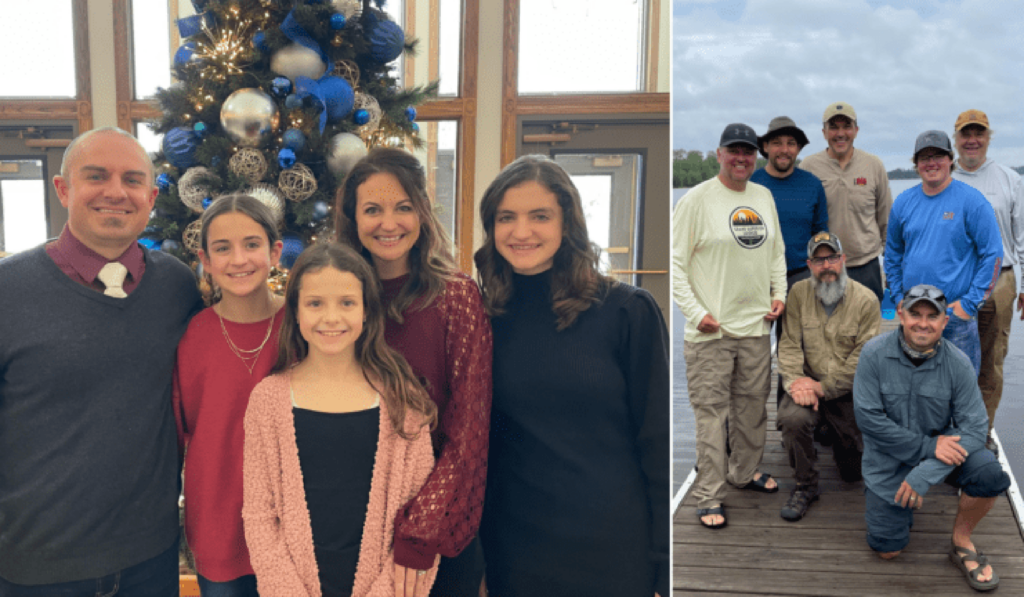
I’m convinced that the discipleship principles that apply in any setting include biblically-grounded instruction and regular shared experiences of vulnerability together. Teaching people God’s Word and sharing life as God’s people are the key ingredients to obeying the Great Commission—no matter where ministry happens. As such, the Church and Bible-loving leadership are indispensable. So, shouldn’t they translate seamlessly from a suburban to a rural context?
In a suburban setting, getting people to “do life” together was more complex, but vulnerable sharing came readily. There are more people with less association in more significant population densities. Because they likely didn’t work and live in the same circles, the risk was lower to being vulnerable, while the challenge of the gathering was higher.
The reverse is true in rural settings. If you’ve lived in one, you know. Life together is everywhere because you know half the grocery store when you walk in. That means vulnerability comes with a greater risk because people work, play and live in your circle. Discipleship thrives at the crossroads of God’s Word and vulnerable communities.
Both suburban and rural settings are fertile ground for Great Commission work. To the suburban discipler, put effort into the gathering. Getting people together for discipleship will be your context’s most significant challenge. To the rural discipler, foster vulnerability by building trust. People are already gathering, so your challenge will be to encourage deep dialogue. God’s Word and our tenacity to keep it front and center must remain committed for both.
Dave Mergens is the Pastor of Adult Formation at Alexandria Covenant Church, host of the 2023 Rural Impact Leadership Conference. Dave’s passion for discipleship has been a mainstay value in his 20 years of vocational ministry. He’s an avid outdoorsman who enjoys quality time with his family and friends doing life in adventure settings.
This article was originally published by Transform Minnesota and is reused by permission.
In August 2017, a devastating gas explosion destroyed Minnehaha Academy’s upper school. Two lives were lost and many injured. In this moment of crisis, Minnehaha’s executive leadership team looked to the Lord and got to work.
At the 2022 Northwest Conference Annual Meeting, attendees heard a presentation titled “Trusting the Good Shepherd: God’s Leading Through the Valley” from a team of leaders from Minnehaha Academy, including Rev. Dr. Donna Harris, President, David Hoffner, Executive Director of Faith Formation, and Sara Jacobson, Executive Director of Institutional Advancement.
Learn practical, transferable leadership principles for your ministry setting, and hear testimony of God’s faithfulness and provision through difficult times to lead this institution toward a hopeful and inspired new future.
Download the Minnehaha Academy Presentation PowerPoint
From the inception of congregational vitality ministry within the Evangelical Covenant Church, we have introduced pastors and congregations to the fact that leadership is both an active and reflective task.
On the one hand, we recognize that effective leaders must respond in the moment to what is happening. On the other hand, leaders must be able to step back from their current moment and assess what is happening from a wider perspective as well. Ron Heifetz and Marty Linsky are two voices who have been primary advocates over the years for this two-dimensional understanding of leadership. The metaphor they utilize to differentiate these two functions of leadership is the dance floor and the balcony.
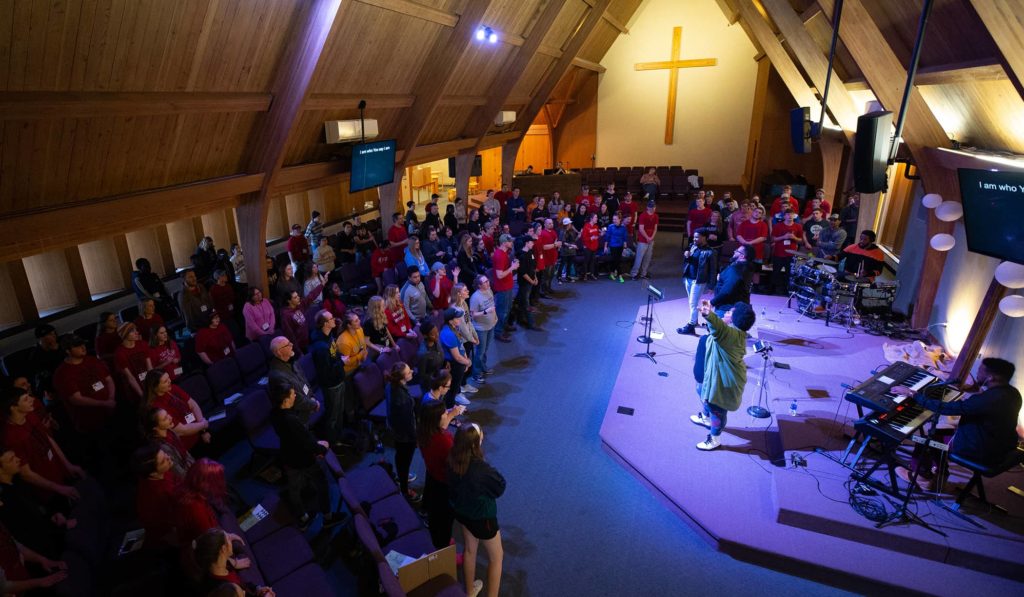
Relative to this, recently the Northwest Conference staff read through Gil Rendle’s book, “Quietly Courageous: Leading the Church in a Changing World.” In one section of his book, Rendle also highlights Heifetz and Linsky’s leadership metaphor of the dance floor and the balcony as important to leading congregations effectively.
He explains: “The dance floor is where the action happens. It is the active place where any group must engage in order to move their work ahead. However, the dance floor (including the committee room) is the least thoughtful space for leaders and workers because it is driven by immediacy that prompts a dependence on what people already know. It is reactive space. In contrast, balcony space is where the leader takes people to withdraw from the dance floor of activity in order to become more reflective.”
It is a leadership discipline to periodically step away from the action—off the dance floor and onto the balcony—in order to establish adequate time and distance from the action to seek greater perspective on one’s current situation. It is intentionally creating space to foster more honest reflection and learning for the group.
According to Rendle, one of the primary tools leaders have to utilize balcony space effectively is open-ended questions. And in his work with congregations over the years, Rendle has developed a series of “cascading” questions of inquiry which invite people into balcony conversations of listening and learning about their own work. Cascading implies only that the questions are arranged in a sequence.
The work of leaders would be to use this list to determine which is the critical conversation of inquiry the people most need to address at any given moment in order to move ahead. What part of their story do they need to revisit to remind themselves to be bold and faithful? What part of their story do they need to question, examine, challenge or rewrite in order to gain more clarity about their purpose? What part of their work do they need to examine in order to learn more?
Following are Rendle’s suggested questions:
Descriptive Work:
1) Who are we, now? (The identity question)
2) Who is our neighbor, now? (The context question)
Discernment Work:
3) What does God call us to do, now? (The purpose question)
The Work of Boldness and Courage:
4) In order to address God’s call, what difference do we believe God has for us to make in the next 3-5 years? (The outcome question)
5) What would it look like in 3-5 years if we are faithful and fruitful with our call? (The possibility question)
Implementation Work:
6) How will we do it? (The strategy question)
7) How will we measure our progress toward fulfilling our call? (The metrics question)
Learning Work:
8) What have we learned from our experience? (The learning/evaluation question)
9) What re-shaping or changing do we need to work on because of what we have learned? (The ready-aim-fire question)
When considering all that we have been through since March 2020, couldn’t we all benefit from some additional balcony space and process as we discern moving forward in our sense of mission? If so, maybe Rendle’s guiding questions can provide you with a helpful framework for your process.
After all, leadership is both active and reflective.
A strong marketing and communication strategy can make the most of readily available, low cost tools to keep your congregation engaged and get your church in front of new audiences. As more churches and public spaces open up throughout 2021, now is the time to consider how the pieces of your brand, website, and marketing efforts work together.
In a series of previous stories, we’ve taken a close look at questions and process related to branding and website design. If you missed those four stories, see the links at the end of this article.
Once your brand is buttoned up, and your website is meeting your visitors’ and congregation’s needs, it’s time to start expanding your reach and driving traffic to the site. Think of your website as the hub of your marketing efforts—and email, social media, print and other tools as your primary drivers to the site.
Here are a few of the essential marketing platforms every church should consider using to connect with people.

Email newsletters are common ground.
An email newsletter is one of the best ways to communicate regularly with your congregation. People all have their preferred social media platforms, but virtually everyone has email. And there are many great options for free or relatively inexpensive email marketing platforms.
The two most common, and most user-friendly services are:
- MailChimp: Featuring a more advanced and easier to use email builder, MailChimp is free for users with under 2,000 contacts, making it a great fit for most churches.
- Constant Contact: The email platform of choice for the NWC, Constant Contact pricing starts at $20/month, and there are more pre-designed templates to choose from, as well as a recently improved email builder. Contact management and email archiving options are slightly more user-friendly on Constant Contact, but the trade off may not be worth the cost for most users.
A weekly email newsletter provides consistency and opportunities to drive traffic to the website. Keep in mind that people scan content quickly, and you will need to repeat important event promotions and other key content for several weeks before many will take notice and click to learn more.
Provide short blurbs that link to longer form content on your website. Give your readers just enough info to glean key details, and entice them to click links or buttons to learn more or register for events.
Social media is for viral content.
The goal in using all social media platforms is to create content that compels people to interact and share. Unlike email newsletters, social media tools are, by design, meant to connect your church with new people via the social networks of those who already follow.
Regardless of the platform, try to include specific calls to action, prompts to share, and questions that require a response. It may feel “pushy” or inauthentic at times, but social media users are accustomed to being asked to like, share and comment. So go ahead and ask away.
The three social media platforms that work well for most churches are:
- Facebook: Although it’s become overrun with advertising and hot-button political content, Facebook still has the most robust tools for churches to facilitate groups, promote events, and share a wide variety of types of content.
- Instagram: Focused on photo and video content, Instagram is a great way to give followers visual insight into the life of your congregation. Make sure to vary your content so the feed doesn’t become exclusively promotional in nature. Check out the Crossroads Church feed for a great example of content mix.
- YouTube: While it’s a great platform for hosting video and livestreaming, remember that YouTube is at its core a social media tool. Make sure to pay attention and respond to comments, and tag content to increase the likelihood of showing up in the platform’s powerful search tool.
With any social media platform, plan to drive some content to your website for event details, sermons and news items, but do make sure to mix it up with posts that are created purely for social media. This will add to the personal and interactive feel of your feed.
Print is not (quite) dead.
Most churches have cut way down on common print materials like bulletins, printed newsletters and other paper goods. Depending on the demographics of your congregation, you may even be entirely paperless. Or you may find that your particular audience still likes to hold onto an order of service or receive mail from the church.
There is no right answer here, except to stay tuned to the needs of your congregation. Even if you’re mostly paperless, consider investing in well-designed welcome packets and seasonal promotions.
For example, during the 2020 holiday season, one church located just west of the Twin Cities created a custom printed Advent calendar with daily spiritual activities for families to engage in while they weren’t able to gather. The campaign connected families worshipping at home across the church body and was a huge success.
Whatever stage your church is at in the development of your brand, website or marketing strategies, it’s important to remember that there’s always room to grow and learn and evolve. And it’s perfectly fine to think of these areas of ministry as a journey. The important thing is to start somewhere, stay active, keep moving and be flexible.
For other stories in our Communications 101 series, visit:
- Brand 101: 2021 presents opportunity to evaluate brand identity as every church ‘relaunches’
- Brand 101: How do you go about evaluating and updating your brand identity?
- Website 101: Questions to answer before redesigning your church website
- Website 101: How do you go about updating your church website?
By Bryan Malley, NWC Director of Communications
Redesigning a website is no small task. There is a lot of information to gather, hundreds of decisions to make along the way, and many hours required to plan, design, build and launch a successful project.
The job may seem daunting at times, but as the “new front door” of your church, your home on the web must get the attention it deserves. And as noted in Part 1 of this series, now is the time to consider updating your online presence as we move toward re-opening public spaces.
Whether you’re working with a website design agency, a freelancer or a team of volunteers from within your church, keep your project committee small (3-5 people), make sure you have input from key decision makers from the start and try to have a single point person for designers and developers to work with.

Process: How do you get started?
As with most any type of design project, a website redesign should begin with conversation. There is a lot to think about—and even more to do—once you get started.
Here are a few of the questions often used by professional designers at the start of a website project:
- List 3-5 main goals for your new website. (Examples: Drive traffic to contact the church, convert site visitors to church visitors, explain ministry offerings, promote events, etc.)
- Define 3-5 key audiences the new website must reach. Include as much information as you can about the demographics and expected behavior of each group as they interact with the new website. For example, a key audience of young families might be expected to search out information on children’s ministry programming over other types of content.
- Provide a short description of your brand using language that describes the “personality” of the brand.
- Are there clear colors, styles of illustrations, graphics, functionality or anything else you absolutely need to avoid because of history or the specifics of your audience?
- List the URLs of as many of your “competitor’s” websites as possible. How are you different from your main competitors?
- List the URLs of any and all inspiration websites you can think of. Provide examples from other churches and from any other sites in other industries you feel have qualities you’d like to see in your new site.
- Describe any unique functionality or how you’d like particular features to work on your new site. Are there external systems the new site needs to integrate with, such as a church database or email newsletter platform?
The answers to these questions should help guide all the decisions that will be made along the way related to words, images, organization and design elements that will come together to comprise the new site.
Start with UX Design …
User Experience Design (often referred to as UX Design), as the name suggests, is the practice of thinking through expected and desired user behavior and organizing a website and its pages in a way that will meet the visitor’s needs most effectively. UX Design includes creating a “site map” of pages, as well as planning what will go on each page from top to bottom.
Plan a site menu structure that uses plain language and is organized with the new visitor in mind. You may have developed some catchy language for your ministry priorities or individual ministry areas, but often these terms don’t make strong navigational items for those who don’t already know what they mean.
A good rule of thumb for your top level menu is to have 7 (+/-2) items that can house most of the other pages required to fill out the site. Some common examples include: Welcome, Ministries, About Us, Events, News, Contact, Giving.
Once you have a complete and organized list of what will go where, you can start to think about the individual pages of your new site.
- Home Page: The most important page on your site, it’s a good idea to start with broad messaging for new visitors, use pictures wherever possible, sprinkle in brand messaging and funnel down to specific promos for things like events, sermon series or news.
- Landing Pages: Are there certain pages on the site that deserve extra hierarchical and/or design attention? Significant design energy will go into the Home Page, but often there’s a second tier of important pages that also require strong design. Examples of Landing Pages might include: I’m New, Events, Sermons or a Ministries page that provides a simple overview of your key offerings and links out to specific pages.
- Standard Pages: Can you create a template that would serve most other page needs? Because church websites often require a higher page count to ensure each group or ministry is represented, you will save significant time and energy if you can plan a single page template with the components required to cover the bulk of the sites third tier pages.
Before you start the Visual Design process, your team should already have a clear vision for how these key page types will take shape, and how a visitor will move through the site.
Visual Design should flow from brand identity.
The UX Design plan, coupled with details about your brand identity, will be the jumping off points to move into this next stage. Visual Design should bring together color, type styles, photos, icons and other graphic elements and result in a website that “feels” like your church.
- The website is a digital extension of your church, and therefore should always flow from the brand identity.
- Use real photography of real people to give an accurate sense of what your church community is like.
- The visual hierarchy of every page should follow your content hierarchy. Bigger, bolder, simpler things go at the top, working downward to more specific, longer form content as needed.
- White space, simplicity and large text are your friends. These design qualities will keep things uncluttered, improve accessibility for users with special needs and keep the new visitor from feeling overwhelmed.
It’s important to visitors as they navigate your site to lean on visual cues that feel familiar. Avoid the temptation to break the mold and be overly creative with placement of key elements from page to page. Certain pages will vary in obvious ways, but visitors should always feel like they’re still within your website.
Why does mobile responsive design matter?
With the proliferation of mobile devices, it’s absolutely critical to make sure your website is mobile responsive. In other words, the display of the website should adjust based on the pixel width of the screen upon which it’s being viewed. According to an article from Sweor called, “27 Eye-Opening Statistics About User Experience, Website First Impressions, and Website Design That You Should Be Taking Very Seriously”:
- 57% of internet users say they won’t recommend a business with a poorly designed website on mobile.
- 85% of adults think that a company’s website when viewed on a mobile device should be as good or better than its desktop website.
Your designer should provide you with layouts for larger desktop monitors, as well as specifically-designed versions of pages for tablets and mobile phones. Often the elements of each page will stack on top of one another, some desktop design elements may be hidden for mobile devices and your site’s menu should feature a mobile-friendly design.
Content and SEO go hand in hand.
Most church website projects will have many stakeholders contributing ideas for what should go on the various pages of the site. In order to maintain a consistent brand voice, and to capitalize on Search Engine Optimization (SEO), there should be one team member aggregating and editing the words for your website.
Here are a few important things to keep in mind:
- Use welcoming and inviting language, not insider speak, to ensure your messaging resonates with new visitors.
- Most internal pages of the website should aim to have 500-750 words on the page. Too much or too little could result in dings against search rankings.
- Determine a key word or phrase for each page, and try to make sure that word appears in the meta description (the snippet shown in search results), first headline and several times throughout body copy on the page.
- Consider using tabs or other methods of organizing less important content for pages that need to house a lot of details.
- Based on your UX Design plan, provide a framework to ministry leaders or staff members submitting content. This helps them tailor their content, along with word counts, and standardizes information delivery from page to page.
You can certainly take SEO further using add-on tools, plugins and tactics to improve your organic search results, but the best starting point for most churches is to remember these basics when drafting content for your pages. Google and other search engines mainly want to know that you’re the “expert” on your specific content. Writing with SEO in mind by having the right amount of content on each page and using keywords enough, but not too much, should result in strong SEO over time. Having strong SEO means that when people search for “church in Warroad, MN” or “youth ministry in Grand Forks” your church will rise to the top of their search results list.
What Content Management System (CMS) is best?
There are myriad options for platforms on which to build a website and almost as many opinions about which CMS is best. The “right answer” to this question is probably a combination of your church’s needs for functionality, your developer’s preferences and your comfortability with the administrative interface for updating the new site.
- Avoid using proprietary CMS options offered by some software developers. These lesser-known platforms don’t have the benefit of open-source development, have less user-friendly interfaces and sometimes result in clients needing to pay for simple changes.
- WordPress is a great option for stand-alone or self-hosted sites with a large enough budget to customize the CMS and front-end design. An experienced design team can do just about anything using WordPress as the underlying platform, without the restrictions of some of the more common hosted platforms below.
- SquareSpace and Wix are good options for simpler projects that don’t require a lot of developer customization. Both platforms offer templates and easy to use page builders for putting together a site without much code knowledge.
With strong design and content, your website has the potential to convey a lot about your brand identity, give new visitors a glimpse into what your church is like, serve your members and attendees with the most up to date info and become the hub for other marketing and communications efforts.
This article is the second in a two-part series on church websites. To read part one, click here.
Also, be sure to check out our two-part series on branding at the links below:
- Brand 101: 2021 presents opportunity to evaluate brand identity as every church ‘relaunches’
- Brand 101: How do you go about evaluating and updating your brand identity?
By Bryan Malley, NWC Director of Communications
Maybe you’ve heard the phrase “your website is the new front door” of your church. While it’s true that people may first come into contact with your congregation through a variety of sources, your website is still the number one place most will turn when taking a closer look.
Every day, people in communities across the Northwest Conference are searching for a church. Even before the COVID pandemic—and even more so because of it—they are far more likely to visit your website before checking out a Sunday service.
Your website is a digital extension of your church. Are visitors getting an accurate and enticing glimpse of your brand and what your church has to offer?
Before discussing how to approach the process of a website redesign, there are some big important questions to answer first.

Who is your website for?
In my experience, having been a part of many church website projects over the years, the question of who the website exists to serve might be the most overlooked.
The conversation often begins with, “We need a new website, and we need it to do this, that and the other thing.” Most of those requests for features and functionality revolve around serving existing members and attendees.
It is definitely possible to design and build a website that meets those needs and more, but a church website should exist primarily for the new visitor. Here’s why: Those who are already a part of your community can be trained to find information about events, sermons and all the other important details of church life over time. You only have one shot to capture the attention of the new visitor, so you must meet their needs in the first few seconds of their visit.
However they arrive at your site, the number one question a new visitor is asking—either consciously or subconsciously—is, “Will I fit in here?” Your goal is to help answer that question quickly with the words and images that are used on the home page and throughout the website.
- Use real photography of real people to give an accurate sense of what your church community is like
- Use welcoming and inviting language, not insider speak, to ensure your messaging resonates with new visitors
- Give new visitors a clear path to an area of the site with detailed information about what they can expect during a first visit, the core beliefs of your church and the ministry work you do
The truth of the matter is only the new visitors that are actually a good fit for your church family will stick in the long run. So it’s important that you focus on giving new visitors a realistic vision of who you are, and work to attract the people most likely to resonate with your church experience.
Why does design matter so much?
Studies show it takes about 0.05 seconds for users to form an opinion about your website, and first impressions are 94% design-related. This becomes the key factor in determining whether visitors stay or leave.
A visitor’s perception of your website carries over to the way they perceive your church as a whole. Is it trustworthy? Does it seem credible? Is the user experience and navigation of the site intuitive and similar to what’s expected?
Why is performance important?
Modern, responsive websites that load quickly and are built on solid user experience design deliver instant credibility. And credibility keeps users on your site longer, increases interaction with the site’s calls to action and is likely to result in people recommending the site to others.
On the other hand, users will bounce quickly from sites that load slowly, aren’t compatible across a range of devices, or are frustrating to move around. Before you start down the path of designing a new website, spend time evaluating your options for hosting and site organization.
How will you keep it fresh?
Stale, dated content or imagery will also cause new visitors to question how active your church is in real life. Before embarking on a project of this scale, or creating new features that require regular posting, consider whether you have the staff or volunteer infrastructure in place to keep content fresh.
Upkeep your website like you do your building, especially since it’s your “new front door.”
This article is the first in a two-part series on church websites. In Part 2 of Website 101, we’ll take a look at a process for engaging a website redesign project.
By Bryan Malley, NWC Director of Communications
The human brain is programmed to identify things quickly. If something is not clearly labeled, we will automatically give it our own label. Branding is about attempting to control what label gets applied to your church via brand identity—messaging, visuals and experiences.
In a healthy brand environment, decisions about website design, promo material design, social media and marketing visuals, signage, apparel and more all flow from the curated brand identity.
So how do you go about distilling the big ideas about your brand down to actionable words and visual elements you can use to help control the narrative?

What’s a healthy process for brand identity creation?
Every freelance designer, small design studio or large branding agency has a unique process to guide clients through branding. While brand designers often approach the challenge in their own way, the process always involves a funnel-like method aimed at distilling many points of information down to a set of parameters that can be used to develop symbolism, styles, colors, words, logos and much more that communicate brand identity effectively.
Here’s an outline of the questions and process often used by professional designers to create visual identities that reflect the essence of the brand identity.
- What is your mission?
- What is your vision?
- What are your core values?
- What does your church do on a practical level?
- What does the name of your organization mean to you?
- What is your positioning statement (often called a tagline)?
- Define your 3-5 key audiences and provide as much demographic information as you can about the expected behavior of each group as they interact with your brand.
- What is the personality of your brand? To spur your thinking in this area, ask yourself: “If someone were to describe your church as if it were a person, what characteristics would they use?”
- What visual characteristics of your brand might capture the key aspects of your mission, vision, values and position?
- What imagery might capture some of the conceptual ideas from Mission, Vision, Brand Characteristics and Positioning Statement?
- Are there color, styles of illustration or photography that should be avoided based on history or specifics of your key audiences?
- List similar organizations and competitors and define how you are different from them.
An experienced brand designer will take your church’s input on these questions, help identify challenges and opportunities, point out conflicting inputs and ask follow up questions designed to gain a deep understanding of who you are and who you want to be, before putting pen to paper to create anything visual.
This outside perspective will often bring new ideas to the forefront, challenge existing assumptions and should result in a tightly defined and agreed upon plan to move forward in the creation of brand messaging, strategy and visual identity, often called a Creative Brief.
Whether you choose to work with an experienced team or agency, or a less experienced freelancer in the creation of the visuals, it’s absolutely critical that there is a process in place to guide design. The results of the process will be the lens through which you evaluate the success of proposed visual solutions and all future design, marketing and communications efforts.
How do you choose a partner?
The visual identity systems that best communicate brand identity don’t stop with a logo. In fact, I’ve heard a logo described as the “period at the end of the sentence,” or the flag you fly to identify yourself. This is because no logo can say all there is to say about a brand identity. It’s but one tool in a toolbox—and all the tools in the toolbox will be needed to help with the fix.
Graphic design, as a profession, covers a wide range of areas of expertise. There are illustrators, publication designers, website designers, production designers, font designers and on and on.
If you’re searching for a partner to guide you through branding, it’s important to connect with a person or team that can show experience in creating and executing a brand identity system. The designer you work with will need to both be able to design a logo, color palette, typography system and set of initial styles that solve your problem AND apply that system in appropriate ways across print, digital and promotional channels.
When you’re deciding who to partner with, take a comprehensive look at their body of work. Do they show work that might resonate with your audience? Can they demonstrate systematic thinking beyond logo design? And do they have any past experience or clients in church or nonprofit branding?
Once you’ve narrowed your list of partners down, ask questions. Interview them as if they were joining your team, because in many ways, they will function that way in the short and long term. How will they approach the challenge? What’s the estimated cost for various phases of the project? What are the final deliverables and who will own the intellectual property?
What’s the ROI?
The branding process is often illuminating, sometimes surprising and should be fun. It’s not always easy, but at the end of the journey you should be equipped with messages and visual tools to better influence perceptions and attract new people to your ministry.
The return on investment is that a fresh brand identity will be a jumping off point for the coming relaunch of in-person worship, future website design, marketing and communication efforts and everything you do to convey brand to the world for years to come.
This article is the second in a two-part series on church branding. To read part one, click here.
By Bryan Malley, NWC Director of Communications
The current “COVID pause” that churches and businesses are enduring imposed many types of hardship throughout 2020. While things are definitely not “business as usual”—especially for churches—the “new normal” that seemingly everyone has been talking about throughout the pandemic will be accompanied by opportunity to jump start your ministry’s brand.
This article is the first in a two-part series on church branding. To read part two, click here.
New year, new you
While it’s true that churches across the Northwest Conference have found creative ways to shift their ministry online and serve many people from a distance, at some point in 2021 the doors will be open again, and your ministry will have the chance to “relaunch.”
Many people have used the time away from church buildings to explore other worship settings. And many who previously did not attend church may be looking for new ways to emerge from isolation and experience community.
Simply put, when it’s time to go back to church, your brand will be part of the decision-making process for those who are looking for a new place to call home.

What is brand?
“Brand” is one of those words that gets applied to so many different things that it’s lost its meaning over time. Let me be clear at the outset: Your brand is not your logo.
Your brand is the perception of your church as it exists in the mind of each individual, family or community—formulated over time by various levels and types of interaction with your organization.
Another way to say it is, your brand is your reputation. Your brand is what people think of you.
In an ideal world, this reputation is a close to accurate reflection of who your church really is, and what its ministry priorities and offerings are. You can’t control what people think of you, but you can act to influence their perception.
Brand vs. branding
If brand is what people think of you, then the process of branding is doing what you can to control the narrative about your church. Branding your church is about clarifying your mission, vision, values, offerings and organizational personality, and then crafting a strategy to use the tools at your disposal to consistently communicate truth about your brand.
The companies and organizations with the most effective branding are those who have taken the time to put definition to what’s “on the inside”—what their brand is and what they want their brand to be—and then invested in a strategy for communicating that value proposition consistently using messaging, visuals and in-person experiences to attract the right people.
This strategy and toolset is often referred to as “brand identity.”
Why does brand identity matter?
The goal in creating and maintaining this strategy is to align what comprises your brand (values, beliefs, reputation and personality) with your “brand identity.” If your brand identity doesn’t align with your brand, people won’t connect.
In my observation working with churches and nonprofits over the years, many have already taken the time to process through the big ideas about their brand. They have at least written down mission, vision, core values and how they want to be understood in the world.
But most have not invested enough in the next step, which is the creation of a strategy, visual identity and tools to accurately portray those big ideas across every possible point of interaction to consumers.
This is the number one area of disconnection for most churches—the quality and construction of the visual identity, website and marketing and communication efforts does not reflect the quality of the actual church experience.
Think of it this way: If your church were a person, then your clothing, hairstyle, cars, house, social media postings, and much more are communicating to others about your brand identity. And that brand identity is being used to formulate reputation.
Since your church is a church, it’s your logo, color palette, photography, signage, website, social media properties, messaging and in-person interactions that make up your brand identity.
Here’s a quick summary thus far:
- Brand – What people think of you
- Brand Identity – What you’re saying and doing to influence what people think of you
- Branding – The process of defining brand, creating brand identity and crafting messaging and visual identity
- Messaging – The words you, your team, and your congregants (brand ambassadors) say about you
- Visual Identity – Logos, graphics, colors, patterns, photos … anything that can be seen and communicate about brand identity
Are the external signals of brand identity doing their job to convey truth about your brand?
Brand assignment this week:
- Ask three people who don’t go to your church to take a look at your website. Have them:
- Describe what they think is important to your church based on what they see.
- Explain what they think the vision, mission and core values of the church are (without looking it up).
- Choose five words to describe your church.
In Brand 101 Part 2, we discuss how to go about evaluating your brand identity and choosing a design partner to guide the process.
By Bryan Malley, NWC Director of Communications
Pastor Linda Norlien, retired Chaplain (Lieutenant Colonel) in the U.S. Army, recently shared this reflection on what it takes to minister well in difficult circumstances and consistently over a long period of time.
May it be an encouragement to us all as we look toward 2021.
Ministry during a global pandemic is presenting challenges most of us have never faced before. Our training and prior experience comes up short in equipping us to face the increases in leadership challenges, decisions and fatigue.
Based on my experience as a retired Army chaplain, I would say this ministry context most resembles the challenges Army chaplains face while deployed to a combat zone.

Ministry in a combat zone
Perhaps a brief account of an experience I had in 2006 in the dining facility at Camp Bucca near Umm Qasr, Iraq, will reveal the resemblance I see. I had just finished my meal when I spotted a fellow chaplain and took the opportunity to walk over and see how he was doing. It was breakfast time and my friend looked exhausted.
I sat down and heard his account of visiting his night shift personnel. He was eating breakfast and preparing to head out to check on his day shift. He was noticeably thin and completely ragged out. Since he was the only chaplain of his military branch on the base, he felt the weight not only of making sure all of his personnel knew him, but that he had addressed all of their religious support needs.
He was weeks into his pattern of making rounds across the entire base—visiting both day and night shifts. He was lacking sleep and losing weight, to say nothing of the strain on his emotional and spiritual life.
I was senior to him in date of rank and on my second combat deployment. I also knew his supervisory chaplain was located on another operating base, so I took the chance to offer him some friendly advice. As we talked, I was able to help him see that he desperately needed to develop a battle rhythm that included regular sleep, quality nutrition, quiet time with the Lord, physical exercise, phone or video conferences with his family back home, regular office hours and some body-and-soul-relieving relaxation with people.
His day and night shift visits were commendable—demonstrating that his heart was in the right place—but not the most efficient pace for long term, sustainable ministry in a combat zone. He thought that the place he was needed most was out where his people were, but he could only be in one place at a time. He was wearing himself out visiting with each of his personnel, but at any given time there might be 10 others unable to locate him.
I conveyed my genuine concern that he was on a trajectory that made him inaccessible to most of his personnel most of the time. He was also harming his health and he would not have the needed reserve energy to draw from if there were a serious incident requiring him to be at his peak emotionally, spiritually and physically.
Our visit went well and ended with him thanking me for my concern. He also pledged to give my recommendations genuine consideration.
Lessons we can use
We know from the testimony of others that the stress and strain of leading churches during this global pandemic is pushing pastors toward exhaustion. So, allow me to offer you some of the lessons we learned as military chaplains while deployed to combat zones.
The most important first step, as I told my friend in Iraq that morning, is to develop a weekly written plan for your time. In the military we called it our “battle rhythm,” which we printed and posted on the doors of our office, chapel and dwelling. That posted schedule informed everyone in our unit, from the most junior soldier to the staff and commander, where we were 24/7. We also made sure everyone had our contact information, so we were accessible, as needed.
An important principle we must recognize is that we cannot physically be everywhere we could possibly be used, so we must be accountable to others for where we are so they can locate us. Treat that plan as your rule of life and exercise and refine it week by week. By making your schedule available, you force yourself to be accountable to discipline your time. Developing and refining that plan every week helps you identify areas you might be neglecting like enough sleep, time with family and personal devotion time.
A second key principle is that it is not enough to simply be present physically if you are so spiritually and emotionally and physically depleted that you are not worth anything when you get there. The most important thing you bring into any conversation, meeting, study, worship service or counselling appointment is your well-rested, emotionally-healthy, Holy Spirit-filled presence.
I am not saying that God will not equip you beyond your own normal capabilities when the situation requires more than you have at that time. However, we are foolish to consistently live beyond our physical and emotional and spiritual capacities, and then expect God to use us when a need presents itself.
To minister well, consistently over a long-term time of unusual stress and strain, we must increase our planning and collaboration time and prioritize better than ever. Look for and ask God where He is working and resist distractions. Choose wisely so you can join God deeply.
In order to build your perseverance watch for and cultivate sources of joy. Have a sleep plan and keep working and refining it. Eat healthy food and drink more water. Nurture healthy friendships of all sorts. Ask God to help you resolve any personal conflicts you have and nurture family relationships, spiritual companions, and hobby and exercise friendships.
Stay connected with those you love intimately. Resist the temptation to take your closest relationships for granted. That will undermine the long-term health of those relationships. Instead, address loneliness before it sets in by connecting deeply.
Be careful to resist the tendency to ignore, deny or dismiss your needs of any kind. Remind yourself that any need you deal with in an unhealthy manner opens up a vulnerability to temptation. Give yourself permission to be affected by the challenges of the situation and address your needs in the moment.
Enjoy healthy sources of humor, sip your coffee slowly, listen to jazz, play your instrument, do art and read a fun novel or biography. Nurture gratitude and actively refuse fear and panic. If you know your Myers-Briggs Personality Type or your Enneagram number, use that insight to be the healthiest version of yourself, addressing the shadow sides of your personality.
Seek God’s presence and involvement in all you are responsible for by cultivating breath prayers, so you can be in an attitude of prayer continually. Recognize and acknowledge beauty and goodness wherever it can be seen. Grieve with faith by putting your confidence in God.
Times like these help us to recognize that what people need most comes from God, not us. But, we do have the privilege of reminding them of that. Nurture collaboration with other ministers and ministries, refusing competition that might have existed before.
In fact, identify what you admire and respect of other leaders and humbly learn from them. Refuse superficiality and legalism, genuinely making more time for the Lord to speak to you. If you have never engaged in the classic disciplines of the Christian faith like silence and solitude, and devotional Bible study, do so now.
Studying for sermon preparation is not the same as employing your contemplative imagination as you reread the stories of Jesus in the Gospels, seeing yourself as the person Jesus is forgiving and healing.
Empower other paid or lay-leaders to lead by coordinating a plan to share, or even hand off, responsibilities appropriate to their gifts and maturity. By prioritizing being accessible you entrust others to contact you when you are most needed and sustain your physical, emotional and spiritual resources, so when you get there you actually minister meaningfully.
Make and keep your appointments with your spiritual director, your counselor, your medical doctor, dentist and physical therapist. In fact, address your medical needs especially if they include pain or interrupted sleep. Remember, God meets us and blesses us where we are, not where we wish we were.
No time is too late to turn your situation over to God and listen afresh for his quiet whisper. Your schedule will still be full, but the planning, preparation and prioritizing I am recommending will equip you to minister well. You will be awake enough to be present and aware enough to be meaningfully working alongside God in what He is busy doing in each life and each ministry opportunity you encounter.
Ten Years Later
Ten years after our time at Camp Bucca, I bumped into my chaplain friend who was now an instructor in the basic course for chaplains just entering service. We had a joyful reunion and he introduced me to his students, by saying this is the Army chaplain I told you about who very likely saved my life.
It turns out that he took my counsel that day in Iraq and used it in every applicable situation thereafter. Now, he was passing the same healthy battle rhythms to these young chaplains who were headed to their own exciting but challenging ministries.
Pastor Linda Norlien
Chaplain (Lieutenant Colonel) US Army, Retired
Children and family ministry leaders regularly get together to share ideas and pray together. At a recent gathering, one ministry leader shared about how her church was starting a mentoring program for kids since COVID-19 has upended ministry as we used to know it.
As the group ruminated on that idea, Polly Inestroza of Crosstown Covenant in Minneapolis wondered about having families “adopt” one another to make sure each family had someone else in the congregation that is caring for them, and checking in with them regularly in this season when we can’t all be together.
Below are Polly’s reflections on Crosstown’s Adopt a Family initiative, two months in:
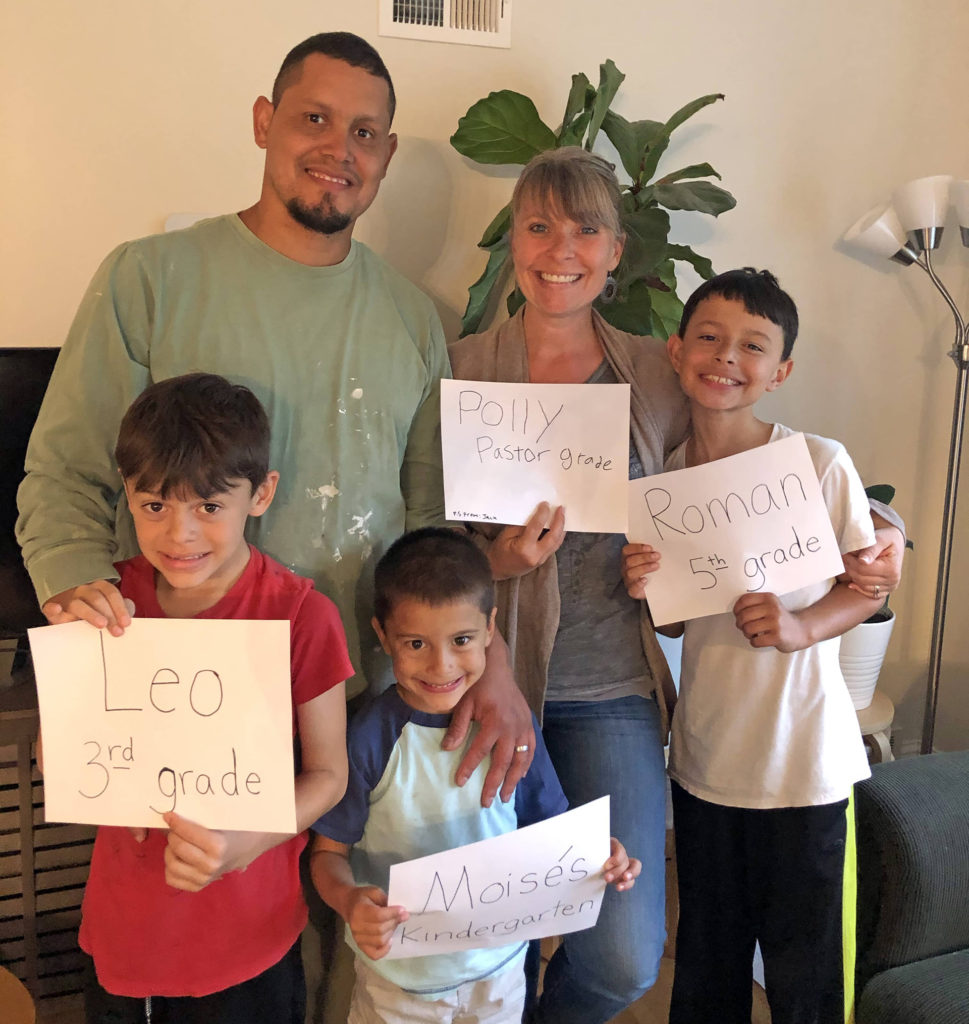
I feel the need to begin this faith story with the disclaimer that this was all God. Down to every detail, God orchestrated this celebration for His glory! I had a prompting of the Holy Spirit one day in late July to go to people’s homes and visit. More specifically, to pray for families. To pray over kids and their parents as they embarked on the school year ahead. To claim joy and victory for people even though they didn’t feel it was theirs to claim.
After months of feeling mildly effective in my role as Children’s Pastor, I knew all I could really contribute for my families was prayer through the Holy Spirit.
I began setting up home visits with all the families at our church—many of whom I hadn’t seen for months. After the first three visits, I was completely amazed with a tension I had never experienced before. I left feeling extremely excited, high, overjoyed and completely full! Which makes sense, right?
I need kids and parents to energize the ministry call that is imprinted on my heart. But, I was also incredibly burdened. The first two home visits, the moms cried when I prayed for them. I could sense the pressure, anxiety and passion in families. I was also amazed that the families I was visiting were willing to enter a holy space on their front steps, with me.
I sat with this tension for a few days before realizing that this burden that I was carrying is not mine alone, but the Church’s. I could visit all 25 families’ homes, take all their prayer requests before the Lord daily and carry this with Him and me. Or, I can delegate this gift to the congregation, and we can all carry each other together. With that, I tweaked an idea that I had heard and created the Adopt a Family ministry, which launched September 2020.
Adopt a Family exists for two purposes: 1) covering each Crosstown family in prayer, and 2) encouraging one another during this difficult time. Each of our families were “up for adoption” and adopted by someone else in our congregation. The adopters vary in age and life stage. One couple recently underwent surgery, and I was able to place them with a COVID-cautious family who is uncomfortable with visitors!
In the welcome packets, adopters were given a list of ideas to encourage—fun little things that would bring joy to a home. Ages of kids and “get-to-know-you questions” were also included, along with a picture of the family.
It’s funny, I heard from a teen household that it has “been interesting receiving cards in the mail from a woman I do not even know.” And, while yes, that may seem weird, isn’t it cool to know you are a part of a bigger movement that cares for each other!
We belong to one another. Praying for and encouraging each other at Crosstown belongs to our whole congregation. Our Adopt a Family ministry not only shares in that work, but I would say it relishes in the glory too. As I left homes feeling energized and purpose-charged, I couldn’t hoard that all to myself.
Praying for one another and encouraging one another can energize all of us, and fuel us through this pandemic!
In these anxious and uncertain days, as the world faces the threat of COVID-19, we remain the body of Christ, dependent on God’s grace and dependent on each other. The Evangelical Covenant Church continues to develop resources covering a range of topics and areas of ministry on its COVID-19 Resources site.
The growing and regularly-updated website offers General Resources, Mission Priorities Resources, details on the ECC’s Financial Relief Initiative, FAQs regarding the decision to cancel Gather 2020, and more. The site also includes resources specific to Latino churches.
The General Resources offered include links to stay connected to the ECC through social media, the Covenant Newswire, weekly prayer gatherings via Facebook Live, and resources from the CDC. General Resources are also offered in specific areas of ministry such as Leadership, Reopening Church, Legal & Financial matters and Technology.
The site also features a section of resources specific to the ECC Mission Priorities.
- The Serve Globally tab includes ways to stay connected to Covenant churches around the world via prayer updates, giving opportunities and articles about how the pandemic has impacted the global Church.
- Make & Deepen Disciples has provided links to online gatherings for Youth Workers and the Crescendo team, as well as Youth & Kids resources, Spiritual Formation resources, tools for small groups and the Blazing Center Resource Suite.
- The Love Mercy Do Justice tab covers Racial Reconciliation and Righteousness, Advocacy for Victims of Abuse, Ministry Development in Season of Crisis, Social Enterprise and additional resources.
- Throughout the Covenant, women are finding ways to help, lead and adapt. They are serving as first responders, ministry workers, and witnesses in their communities of God’s powerful and soothing presence in this pandemic. A Women’s Initiatives tab includes stories of these courageous acts form across the denomination.
Check back often as new resources are being added on a regular basis. We remain grateful that even as we navigate new ways of being in community, the ECC is leading the way forward: https://covchurch.org/covid-19/
You’re not a big church. You’re also not a high-tech church. But you’ve been streaming your church service for the past few weeks and you realize that this is something you want to keep doing for the long haul. Streaming from a cell phone has worked up until now, but it’s time to upgrade to make the experience better.
The Basics
To do basic streaming, all you need is to prop a phone up on a bookshelf and stream directly. It helps if you have a strong Wi-Fi. In some areas of our Conference, where Wi-Fi is weak, it’s better to broadcast using the data plan from your phone. If that’s the case, think about getting an unlimited data plan through your cell phone or cable provider.
Before you purchase a lot of equipment, what do you have that you can utilize? It might be possible to save money by tweaking or repairing what you can access right now.
These are the basics that many churches have already that can provide a good backbone for streaming:
- A sound board
- A wireless microphone
- An ethernet cord (either a Cat 5e or Cat 6)

The Next Level
When you’re ready to take the next step in streaming, here are some ideas:
Equipment
Capture Card
If you’re more than four feet away from your camera or microphone, you’ll need to figure out how to capture the audio and channel it into your computer. One way is to get a sound capture card ($20-$200). If you want to record both audio and video, use a game capture card, like video gamers use. Elgato is an example and will run you about $200.
For more about what a capture card does, click here: https://www.hotrate.com/articles/what-does-a-capture-card-do/
USB Audio Interface
Simply said, an audio interface is what gets sound into and out of your computer. “This is probably the most important piece to our process,” says Mike Bechtold of First Covenant in Red Wing, when asked about his church’s streaming process. “I noticed when I plugged straight laptop into my computer, I had either looping issues or a lot of white noise feedback.”
When it comes to input, an audio interface allows you to plug in XLR cables for your microphones, or a wireless mic. You can also connect it to your church sound system output, which allows you to use your church’s microphones and band plug ins. The output of the audio interface is a USB which plugs into your computer.
To read more about audio interfaces, click here: https://www.musicrepo.com/what-is-an-audio-interface/
Bechtold recommends Focusrite (available from Amazon for about $159).
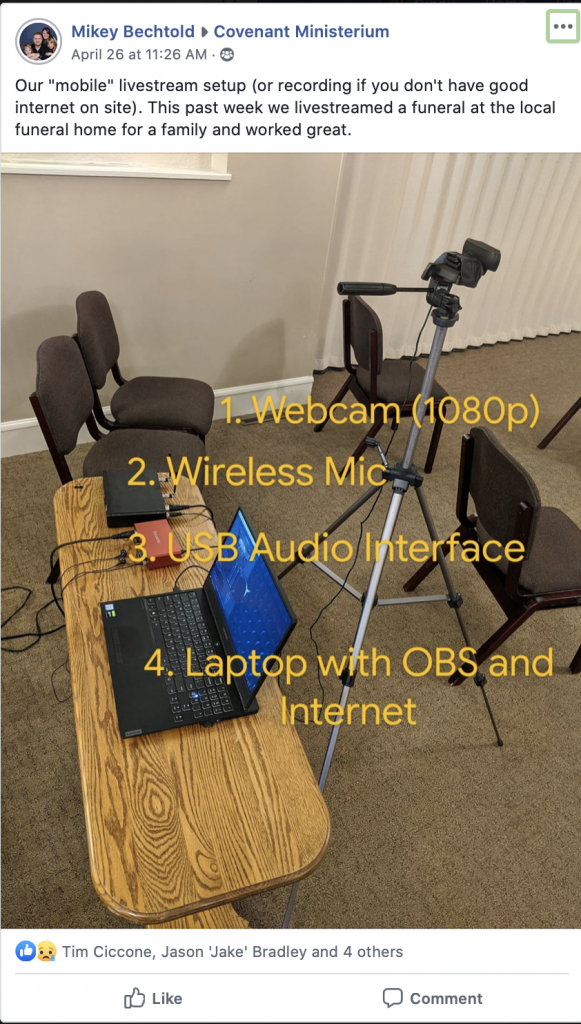 Camera:
Camera:
You’ll want either a web cam or a digital cam that can plug into a computer. This will give you a higher quality image. A decent camera will cost you from $150 on up. Note: the prices have increased during the pandemic. If that’s out of your price range, check around for a good used one. If you’re buying a new one, you want one that has at least 1080p resolution.
Inexpensive: Logitch C920s is a good option if you’re just entering into streaming.
Midrange: An example of a good choice for this next level is Zoom Q8 2.3K HD Handy Video Recorder with Interchangeable Mic
High end: Vaddio RoboShot 30E Elite Series camera (around $3600+). This camera allows you to easily move from panorama shot to a high definition close up. It also allows you to operate it remotely, which means you can place it on the ceiling if need be.
To read more about choosing a web cam, click here: https://www.lifewire.com/before-you-buy-a-webcam-2640480
Production Software
There are several software programs available to help you produce your service.
OBS: OBS stands for Open Broadcaster Source. It’s a free, open source software designed for video streaming. It helps you design and produce your services. For example, if you pair it with Easy Worship (which is what Bechtold uses), you’re able to post song lyrics, then seamlessly switch to the Scripture reading, then switch to the preacher.
Sling Studio: This program is at the high end at $1000. It’s a portable system that can be used with multiple cameras. According to its website, it allows you to monitor, record, switch, edit and stream live HD-quality video wirelessly.
Facebook Live Producer and YouTube Studio are software programs that help you produce your live stream directly from those two sites. Tony Ducklow, president of Church Wrench, recommends going with YouTube.
“YouTube is easier to manipulate afterwards and people are going to specifically look for your account (versus randomly scrolling through Facebook),” Ducklow said.
There are also several presentation software programs to consider: Easy Worship is the one First Covenant in Red Wing uses. Others use ProPresenter. These presentation software programs provide a way for you to stream your camera source through the software first, making it much simpler to use OBS.
As you think through what you want to invest in, it’s good to ask the question if you think you’re going to do this for the next month or the next 10 months? Your answer to that question will help you decide how much time and money you want to invest in streaming.
Many thanks to Mike Bechtold (Associate Pastor of Youth, First Covenant Church, Red Wing, MN) and Tony Ducklow (Church Wrench) for their willingness to share their knowledge and experience.
Church leaders are reliant on the internet more than ever before. Just as a static cell connection disrupts a conversation, poor internet connectivity can disrupt ministry. Here are five tips for improving your internet service.
1. Connection
During this season when we’re so internet reliant, you should be paying for a connection that is running at 100 Mbps for a download and at least 5 Mbps for uploading. This speed is good for two-three people in a home. However, if someone in your family plays a lot of video games or if you have teenagers in your home, you’ll likely need a higher rate.
If you don’t want to pay for a higher connection speed, you may need to have a conversation with others in your home about who can be using the internet for what purposes and when. For example, no video games if someone’s on a Zoom call.
You may also want to check if your cell phone has better connectivity than your router. Run a speed test to see what your download and upload speeds are currently. Ookla offers an app called Speedtest that allows you to quickly see your performance metrics. You can find it at www.speedtest.net
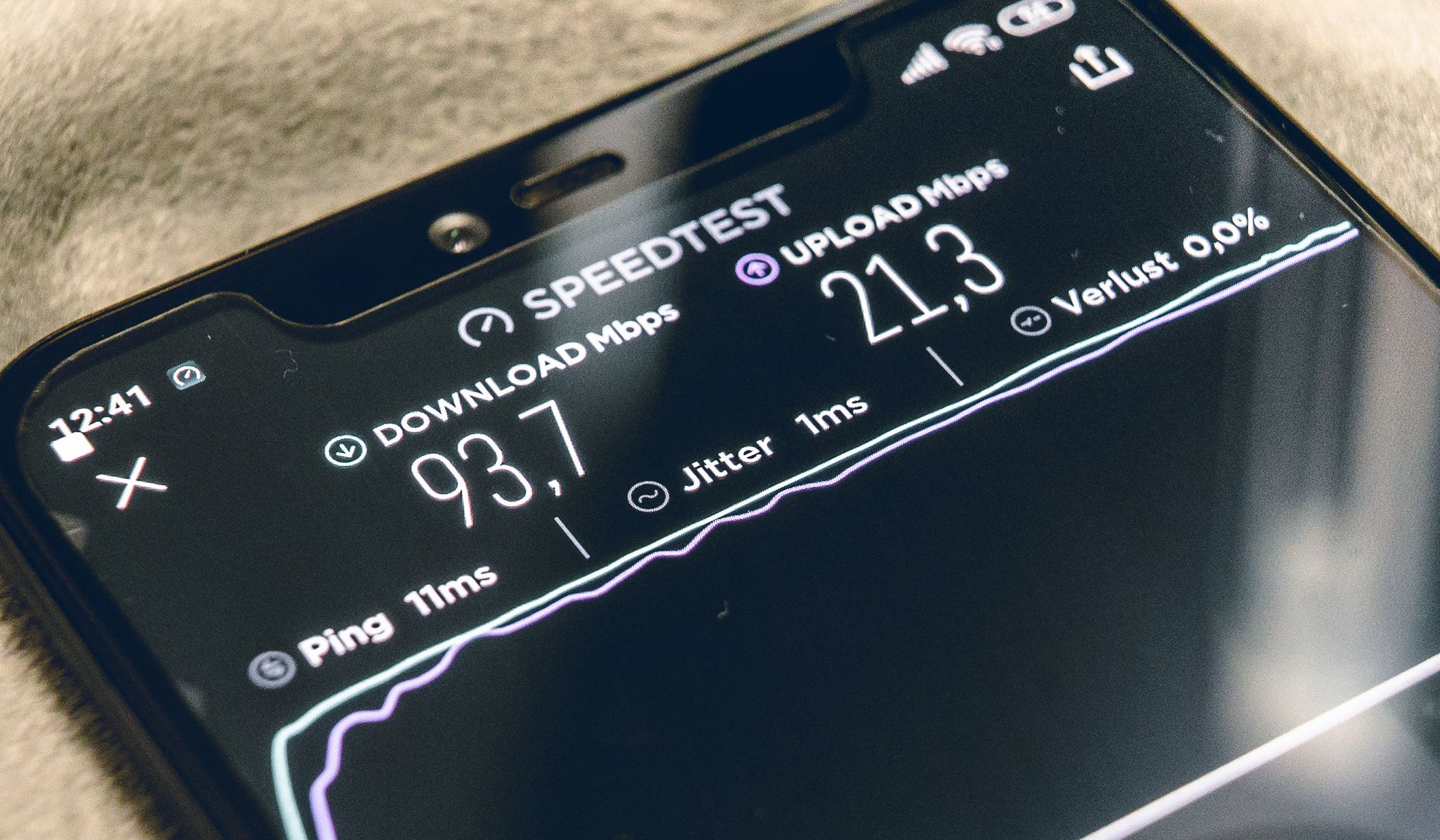
2. Negotiate
If you’re looking to increase your connectivity rate, but the price that your internet provider is advertising seems too steep, call and negotiate. It’s important to note that kindness and patience goes a long way with these negotiations. Let the provider know that you’re not interested in a year-long contract. Ask what they can do for you on a month-to-month basis. If the representative isn’t willing (or able) to negotiate, call back later and talk to another rep.
3. Router Location
Make sure your router is elevated up off the floor. It should be at least at desk-level, or in a bookcase, and away from walls and windows. The higher you go, the more coverage you’ll get.
The exception is if it’s located on the second floor in a home, then place it on the floor so the signal reaches the first floor as well as the second. Point the antennas upwards. If you need your whole home to have access to Wi-Fi, place the router in a central location. Think about your router as a radio; the closer you are, the better you can hear the signal.
4. Router Age
If you’re having trouble with your internet service, check the age of your router. It should be manufactured in the last three years. The standard these days is 802.11N but an 802.11ac will still serve its purpose.
For more information on router age, click here https://www.lifewire.com/802-11n-wireless-network-818281
5. Cables
Double-check all your ethernet and cables. Sometimes a loose link is all it takes to muck up your connection. Check to make sure you’re using a Cat 5e or Cat 6 cable to connect to your router. If you’re using Zoom a lot, consider using a cable instead of Wi-Fi. You’ll get a stronger, steadier signal. A good cable will cost about $30-$40.
A couple of websites that offer decent prices on cables:
- Monoprice.com is great for cheap cables.
- Swappa.com for used computers and iPads
- Backmarket.com sells refurbished electronics
- Mycablemart.com is located in the Twin Cities, if you’re looking to buy local
If you’re interested in reading more, these articles go more in-depth:
- A very practical article (a bit on the technical side) that helps you compare internet services: fiber, cable, DSL, dial-up, fixed wireless LTE (common in rural settings), satellite or 5G: https://www.cnet.com/how-to/best-internet-providers-for-2020-cable-dsl-satellite-more/
- This article addresses how to boost your Wi-Fi signal by changing channels on your router, plus more ideas: https://techxplore.com/news/2020-04-boost-internet-home.html
Next week, we’ll explore what equipment you need for streaming various church gatherings and meetings.
Many thanks to Tony Ducklow and Matt Aalseth for their contributions to this article. Tony Ducklow runs Church Wrench, which helps churches with their online streaming services. You can find him here: https://youthministryland.com. Matt Aalseth is the Director of Youth Ministry for the Pacific Southwest Conference and an internet technology guru.
Looking for a practical way for your church members to serve? Have them make homemade COVID-19 face masks to donate to health care workers, hospitals, nursing homes, transitional programs, etc. Mary March, co-lead pastor of New City Covenant Church, mother of four, Covenant Asian Pastors Association President, and ECC Mosaic Commission chair, has a very busy life. She also has a love for pastors, having parents who are both retired Korean United Methodist clergy.
Being a busy mom, education encourager for her children, pastor and leader in this high-stress season led Mary to find a stress release: making COVID-19 masks. She’s made about 11 different kinds of masks and demonstrates how to make a highly efficient version that takes only three minutes to make.
In her YouTube debut, Mary shows you how to make this researched, effective face mask, using Scott Shoptowels, staples, masking tape, a pipe cleaner (or tin foil) and two rubber bands. And it only takes three minutes to make!
 Many of these can be done in a low-key way, without speedy internet!
Many of these can be done in a low-key way, without speedy internet!
Sometimes when we see lists we get overwhelmed. Instead, we hope this list gives you some ideas not to add one more thing to your plate—but to help your people connect with each other and their risen Lord, and experience a deep time of worship and renewal even in this moment.
Remember, you can’t do everything. Give yourself grace. Rest well and seek to serve God and the people in your community strategically. Pick a few things or one thing and do them well.
- Encourage your church to do a time where you all pray or read scripture at the same time of day. Even if your tech does not allow you to connect, this is a fantastically simple and ancient community activity. Some churches are even mailing out daily devotions to parishioners.
- Invite your church to each send a picture over text or e-mail to other members of your church along with a prayer or note of encouragement on Easter Sunday. Again this is highly relational and easy to do. Think of it like a digital calling tree.
- Ask each member of your church to rent or stream a movie like the “The Passion of the Christ” or read the Easter account from scripture and invite your community to a moderated conversation online to discuss the text/movie.
- Create an Easter playlist on Apple Music, Spotify or some other streaming service. Don’t have access? Invite people to suggest their favorite Easter music, make a list and mail that to people. Or photocopy pages of the hymnal and mail to people.
- Find another pastor or ministry leader, call them and swap “best ideas” for Easter. You don’t have to reinvent the wheel!
- Host a QR code (Geocache) Easter egg hunt in your neighborhoods. That way no one has to touch anything and if it’s outside you are social distancing. This works well for small town churches where most of the church lives within a 10 minute radius.
- If you are looking for a way to pray through Holy Week this year, Lilly Lewin (author of “Sacred Space”) designed a prayer experience based on a centerpiece and five candles that can be used on your dining or coffee table and prayed around with your family, housemates or on your own. It starts on Sunday and finishes on Easter Sunday morning, taking you through the last week of Jesus’ life: https://godspacelight.com/2020/03/27/freerange-friday-holy-week-at-home-praying-with-a-centerpiece/. The website GodSpaceLight.com has other experiential Holy Week resources as well: https://godspacelight.com/church-calendar/
- Online Passover. Register for a time to experience the ancient Jewish feast of Passover and the last supper Jesus shared with his disciples. Meet Jewish staff from around the world, hear their life-changing stores and ask questions through an interactive Q&A: https://jewsforjesus.org/christ-in-the-passover-online
- Chalk the Walk, print yard signs with service times, and other practical ideas for inviting your neighbors to online church from LifeChurch.tv: https://openblog.life.church/ideas-for-easter-at-home/
- Low tech option: Movie theatre “drive-in church” or “drive-up prayer” stations. See these cool stories on doing this here: https://www.nbcnews.com/news/us-news/churches-offer-drive-services-coronavirus-forces-social-distancing-n1170896
- Create a “Zoom Easter Coffee Hour” for your church. There is a free version of this software that is easy to set up and a fun way to see faces on Easter Sunday. Have kids make “lego tombs” to show off during the coffee time (https://zoom.us). More advanced Zoom options (for a pretty cheap purchase price) can even be an option to host services online.
- Signs of Hope outreach idea. Good exercise, community connections and creative evangelism.
- We are not the only ones trying to figure this “digital Easter” thing out! Here are a few other denominations or organizations putting out creative guides that are feasible and not overwhelming! https://www.la-umc.org/easter2020 and https://churchmarketinguniversity.com/the-ultimate-coronavirus-guide-for-churches/
- If you want to “live stream” your services, Facebook and YouTube are the most user friendly. BEWARE however that you need good internet speed and Sunday a.m. on Facebook has been a bit iffy given how many churches are using this option … So what if you plan a “live digital” service on non-peak time? You can also upload services ahead of Sunday mornings to make them run smoother and not demand fast internet connections during the actual time the service is streamed by your people. Details here: https://www.wix.com/blog/2019/02/how-to-upload-video-youtube-guide/. Note: YouTube uploading and streaming is slightly less intuitive than Facebook and you need a YouTube account first to post or stream. Use Google to find out more.
- Online giving is also something to consider if you currently don’t have a provider for this. Many options are available: Tithly https://get.tithe.ly or https://www.planningcenter.com/giving are two of the easiest to use. Obviously this is not the point of Easter but was added to the list given the nature of the moment.
NWC staff members have compiled this growing, curated list of resources and articles as we continue to learn together how to do ministry in this time of coronavirus. Please use common sense and always follow the guidelines outlined by your state and regional health departments. if we can be of continued service to you, please do not hesitate to contact a NWC staff member directly or the Conference office at 612-721-4893.
Last updated 12/11/2020.
10 questions in 10 minutes with Sara Sosa from Plymouth Covenant on how they’ve adapted their ministry to strengthen connections with the home by intentionally partnering with parents.
10 questions in 10 minutes with Sanctuary Covenant’s ministry leaders Rose Lee-Norman and Tara Hollingsworth on how they’ve focused on intergenerational ministry in their context.
 The Department of Labor is increasing the minimum salary requirement for exempt workers from $455 to $684 per week effective January 1, 2020. This means that if you currently pay an employee a flat (salary) amount less than $35,568 per year, overtime pay rules will apply effective January 1, 2020.
The Department of Labor is increasing the minimum salary requirement for exempt workers from $455 to $684 per week effective January 1, 2020. This means that if you currently pay an employee a flat (salary) amount less than $35,568 per year, overtime pay rules will apply effective January 1, 2020.
See page 4 of the Hiring Guide in the Downloads tab below for all the requirements that must be met for an employee to be considered exempt from minimum wage and overtime laws.

Can we talk about background checks? It’s 2018, and we’re officially past the point of making excuses for why churches would not do proper screening on their volunteers. Claiming “we all know each other” doesn’t cut it anymore.
Parents expect adults who work with their children to be trained and screened, and the safety of our kids demands it. Background checks are an important step to weed out obvious predators and are one part of a robust screening process.
This, along with abuse prevention training and careful oversight, are the critical steps that contribute toward a comprehensive safety system for our kids and vulnerable populations.
On Nov. 8, the Northwest Conference, along with Covenant camps in MN, offered a one-day Ministry Safe training on abuse prevention. Over 200 people learned about the sobering reality of child abuse and were equipped with the tools needed to implement a safety system in their ministries.
If your church already has a safety system in place, great. If you’d like to know about how to get started, please contact the Conference office.
Finally, know that the vast majority of adults desire children to be healthy and safe. Unfortunately, our culture believes churches are willing to sweep abuse accusations under the rug. Let’s change the narrative and let the Church lead the way in making sure the next generations can hear the good news of Jesus in a loving and safe environment.
 While many are still scratching their heads over what to do with Millennials, Generation Z (kids born between 1997-2015) have snuck up on us and now represent nearly 25 percent of the population. This unique generation invites the Church to pay attention so that effective ministry can take place.
While many are still scratching their heads over what to do with Millennials, Generation Z (kids born between 1997-2015) have snuck up on us and now represent nearly 25 percent of the population. This unique generation invites the Church to pay attention so that effective ministry can take place.
When the Millennials came of age, we made the shift from digital immigrants to digital natives. The next generation, GenZ, had a digital footprint from before they were born, thanks to parents posting their sonograms on Facebook.
Whereas generations before GenZ had most of their friendships located in their communities with maybe one or two long-distance pen pals, these digital natives were born into global citizenship. It’s a generation that can have more in common with kids their age around the globe than they do with adults in their own country.
Global citizens
Being a global citizen makes young people more aware of the scale of problems around us. Terrorism, war and climate change rank high as legitimate fears for our kids.
Thankfully, young people deeply desire to be part of the solution. According to a survey by the Brookings Institute, “Two-thirds said they crave the opportunity to make a ‘contribution to society beyond themselves and their family.’”
Setting politics aside, you can’t help but be amazed at the ability of young people to organize a national movement to advocate for reform with our nation’s gun laws after the Parkland, FL, shooting at Marjory Stoneman Douglas High School. This generation sees themselves as leaders, able to organize a national movement through social media. Having been tech-savvy since their nursery days, they are already experienced in knowing how to get a message out in a way that attracts others’ attention.
Previous generations of teenagers have advocated for change, whether here in the U.S. with the Greensboro sit-ins in the 1960s, in South Africa with the anti-apartheid movement, or via the pro-democracy protest in Tiananmen Square, Beijing. The difference is that this current generation knows how to organize more quickly and more broadly than ever before.
What can we do?
It’s urgent that the Church learn how to engage this generation that is globally connected and yearning to make a difference. Here are some ideas:
1. Give children and young people an opportunity to engage in compassion, mercy and justice-minded issues.
Show them the Church cares about things that matter to them and to the world. Teach and model biblical justice, not in a way that only caves to the pressures of society, but in a way that keeps the incarnate Christ who walked this earth at the center of all we do.
2. Invest in children and youth ministries.
We know families are busy and don’t prioritize church. So, take the Church to families. Partner with local schools and community centers, send your kids to CHIC and Go:Serve so they can hear God’s invitation to mission and can connect with other like-minded young people.
3. Engage the home.
Eighty-nine percent of young people still say parents are the greatest source of influence when it comes to values. Equip parents and grandparents, fight for healthy marriages, and advocate for robust intergenerational mentoring so that older generations can love and mentor and learn from the young ones.
Generation Z is our future. They are also our present. The Church needs to take this generation seriously. Believe in them, teach them well, and equip them to bring Christ to the world in both word and deed.
Of our 140+ Covenant churches in the Northwest Conference, less than 20 have staff devoted full-time to children’s ministry. Forty have part-time staff and nearly 90 of our Conferences churches have children’s ministries that are led by volunteers.
When your church is staffed at less than capacity, building a thriving ministry with children and families will require more intentionality, and a mentality that views leadership for children’s ministry as more than simply “covering the bases.”
Here are five things to consider with your volunteer-led children’s ministry.
1. Are expectations clear and appropriate?
We all like to know what we’re being asked to do. Even volunteers will benefit from having a job description. Those who work in children’s ministry are generally resourceful, passionate and dedicated to the task. Without clear and reasonable expectations, children’s ministry can become a hamster wheel of details that leads to burnout.
2. Are priorities clear?
In ministry, there will always be work that doesn’t get done. Make peace with the fact that your church won’t be able to offer all the programs of the church down the street. Discern what you will be about, and do that well.
3. Is there a clear chain of command?
To whom is the children’s ministry leader accountable? Is it clear how decisions are made, budget is managed, facilities are maintained, supplies and curriculum are determined, and what safety policies are implemented? Clearly articulating all of this up front helps to avoid the difficult situation of giving someone responsibility over something without authority to make it happen.
4. Does the ministry leader have a seat at the table?
In other words, who will advocate for this ministry area when broad leadership decisions are made? For example, a leadership team may decide to have multiple Christmas Eve services, then inform the children’s ministry team that childcare is needed. How would the conversation change if children’s ministry leaders were invited to give voice on the front end about how to creatively meet the needs of families during Advent?
5. What is the plan for training?
God has a long history of equipping those God calls, and children’s ministry is no exception. Intentional training and connections helps our volunteer leadership move from a place of “filling holes,” to strategic investment in the lives of kids and families. Help your volunteer leaders be successful by encouraging a learning mentality that allows your leaders to grow into the role to which God has called them.
Thank you to all of the children’s ministry leaders and volunteers for your work with kids and families. Praying along with you that your ministry impacts lives and kids, and families will know the love of God.